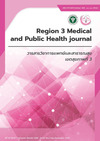การศึกษาเปรียบเทียบ Nefopam และ Tramadol ต่อการระงับปวดหลังผ่าตัดในผู้ป่วยที่ได้รับการผ่าตัดถุงน้ำดีโดยใช้กล้อง: การศึกษาแบบสุ่มและมีกลุ่มควบคุม
คำสำคัญ:
ผ่าตัดถุงน้ำดีโดยใช้กล้อง, ความปวดหลังผ่าตัด, Nefopam, Tramadolบทคัดย่อ
วัตถุประสงค์: เพื่อเปรียบเทียบประสิทธิผลในการระงับปวดหลังผ่าตัดถุงน้ำดีโดยใช้กล้องของยา Nefopam และ Tramadol และอุบัติการณ์ของผลข้างเคียงที่อาจเกี่ยวข้องกับการใช้ยาดังกล่าว ในโรงพยาบาลสวรรค์ประชารักษ์
วิธีการศึกษา: เป็นการวิจัยเชิงทดลองแบบสุ่มชนิดมีกลุ่มควบคุมโดยมีการปกปิดข้อมูลทั้งสองทาง (Double-blind randomized controlled trial) โดยเก็บรวบรวมข้อมูลผู้ป่วยไทยอายุ 18-65 ปี ที่เข้ารับการผ่าตัดถุงน้ำดีโดยใช้กล้องใน โรงพยาบาลสวรรค์ประชารักษ์ ตั้งแต่เดือนกรกฎาคม พ.ศ. 2566 ถึง เดือนตุลาคม พ.ศ. 2566 ทั้งหมด 70 คน โดยแบ่งเป็น กลุ่ม Tramadol จะได้รับยา Tramadol เพื่อควบคุมความปวดหลังผ่าตัด 35 คน และกลุ่ม Nefopam จะได้รับยา Nefopam หลังผ่าตัด 35 คน และเปรียบเทียบประสิทธิผลจากยา 2 กลุ่มโดยประเมินจากผู้ป่วยบอกคะแนนความปวดด้วยตัวเองโดยใช้ Numeric Rating Scales (NRS)
ผลการศึกษา: จากการประเมินความปวดหลังการผ่าตัดถุงน้ำดีโดยใช้กล้อง พบว่าคะแนนความปวดขณะพักของกลุ่ม Nefopam ที่เวลา 30 นาที 3 ชั่วโมง 6 ชั่วโมง 12 ชั่วโมง และ 24 ชั่วโมงหลังผ่าตัดมีค่าเฉลี่ยต่ำกว่าคะแนนความปวดของกลุ่ม Tramadol อย่างมีนัยสำคัญทางสถิติ (p-value<0.05) และพบว่าอาการข้างเคียงที่พบมากที่สุด 3 อันดับแรกในทั้งสองกลุ่ม ได้แก่อาการคลื่นไส้อาเจียน เวียนศีรษะ และปากแห้ง โดยพบว่ากลุ่ม Nefopam มีอุบัติการณ์คลื่นไส้อาเจียน ร้อยละ 25.7 ซึ่งต่ำกว่ากลุ่ม Tramadol ซึ่งมีอุบัติการณ์คลื่นไส้อาเจียน ร้อยละ 51.4 อย่างมีนัยสำคัญทางสถิติ (p-value=0.03) ส่วนผล ข้างเคียงอื่น ๆ พบว่าไม่มีความแตกต่างกันระหว่างทั้งสองกลุ่ม
สรุป: การให้ Nefopam 20 มิลลิกรัม มีประสิทธิผลสามารถลดระดับความปวด 24 ชั่วโมงแรกหลังผ่าตัดถุงน้ำดีโดยใช้กล้อง และอุบัติการณ์เกิดคลื่นไส้อาเจียนน้อยกว่า เมื่อเปรียบเทียบกับ Tramadol 50 มิลลิกรัม
คำสำคัญ: ผ่าตัดถุงน้ำดีโดยใช้กล้อง, ความปวดหลังผ่าตัด, Nefopam, Tramadol
เอกสารอ้างอิง
Edward ND, Barclay K, Catling SJ, et al. Day care laparoscopy: A survey of post-operative pain and assessment of the value of diclofenac. Anaesthesia 1991;46:1077-80.
Soper NJ, Stockmann PT, Dunnegan DL, et al. Laparoscopic cholecystectomy. The new ‘gold standard’? Arch Surg 1992; 127:917.
Schirmer BD, Edge SB, Dix J, et al. Laparoscopic cholecystectomy. Treatment of choice for symptomatic cholelithiasis. Ann Surg 1991;213:665.
Wiesen SM, Unger SW, Barkin JS, et al. Laparoscopic cholecystectomy: the procedure of choice for acute cholecystitis. Am J Gastroenterol 1993;88:334.
Wilson RG, Macintyre IM, Nixon SJ, et al. Laparoscopic cholecystectomy as a safe and effective treatment for severe acute cholecystitis. BMJ 1992;305:394.
Rattner DW, Ferguson C, Warshaw AL. Factors associated with successful laparoscopic cholecystectomy for acute cholecystitis. Ann Surg 1993;217:233.
Johansson M, Thune A, Nelvin L, et al. Randomized clinical trial of open versus laparoscopic cholecystectomy in the treatment of acute cholecystitis. Br J Surg 2005;92:44.
Yamashita Y, Takada T, Kawarada Y, et al. Surgical treatment of patients with acute cholecystitis: Tokyo Guidelines. J Hepatobiliary Pancreat Surg 2007;14:91.
Zhao T, Shen Z, Sheng S. The efficacy and safety of nefopam for pain relief during laparoscopic cholecystectomy: A meta-analysis. Medicine (Baltimore) 2018;97:e0089.
TobiasJD. Pain management following laparoscopy: Can we do better? Saudi J Anaesth 2013;7:3-4.
Redan JA, Wells T, Reeder S, et al. Reducing opioid adverse events: A safe way to improve outcomes. Surg Technol Int 2016;28:101-9.
Brune K, Patrignani P. New insights into the use of currently available non-steroidal anti-inflammatory drugs. J Pain Res 2015;8:105-18.
Klasco RK (Ed): DRUGDEX® System. Greenwood Village, Colorado: Truven Health Analytics; Vol. 167.
Putland AJ, McCluskey A. The analgesic efficacy of tramadol versus ketorolac in day-case laparos copic sterilisation. Anaesthesia 1999;54:382-5.
Philippe G, Marcel C, Marc V. Nefopam analgesia and its role in multimodal analgesia: A review of preclinical and clinical studies. Clin Exp Pharmacol Physiol 2016 Jan;43(1):3-12.
Swarnkar YK, Gupta R, Arora AM, et al. Comparison of Intravenous Nefopam and Tramadol for Post-operative Analgesia in Adult Patients Scheduled for Laparoscopic Abdominal Surgeries under General Anesthesia: A Prospective, Randomized, Double-Blind Study. Indian Anaesth Forum 2022;23:25-30.
Sudsayam M, Aumjit W, Somboon T, et al. Perioperative Pain Management for One Day Surgery (ODS) and Minimally Invasive Surgery (MIS) by the Royal College of Anesthesiologists of Thailand. Thai J Anesthesiol 2021; 47(4):395-407.
Malinee W. Post-operative Nausea and Vomiting: An Update. Srinagarind Med J 2000; 15(4):282-6.
Palaian S, Mishra P, Chhetri AK, et al. Vomiting due to tramadol: a short report from the regional pharmacovigilance center, Western Nepal.J Clin of Diagn Res.2008; 2(1):709-711.
Phakaporn C, Pityaporn C, Petcharat T. Analgesia after Administration of One or Two Dose of Nefopam for Appendectomy: a Randomized Controlled Trial. Thai J Anesthesiol 2019; 45(1):27-33.
ดาวน์โหลด
เผยแพร่แล้ว
วิธีการอ้างอิง
ฉบับ
บท
การอนุญาต
ลิขสิทธิ์ (c) 2024 Region 3 Medical and Public Health Journal - วารสารวิชาการแพทย์และสาธารณสุข เขตสุขภาพที่ 3

This work is licensed under a Creative Commons Attribution-NonCommercial-NoDerivatives 4.0 International License.




